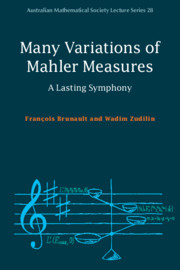
-
Select format
-
- Publisher:
- Cambridge University Press
- Publication date:
- May 2020
- May 2020
- ISBN:
- 9781108885553
- 9781108794459
- Dimensions:
- Weight & Pages:
- Dimensions:
- (228 x 152 mm)
- Weight & Pages:
- 0.27kg, 180 Pages
- Subjects:
- Mathematics (general), Mathematics, Number Theory
- Series:
- Australian Mathematical Society Lecture Series (28)
You may already have access via personal or institutional login- Subjects:
- Mathematics (general), Mathematics, Number Theory
- Series:
- Australian Mathematical Society Lecture Series (28)
Book description
The Mahler measure is a fascinating notion and an exciting topic in contemporary mathematics, interconnecting with subjects as diverse as number theory, analysis, arithmetic geometry, special functions and random walks. This friendly and concise introduction to the Mahler measure is a valuable resource for both graduate courses and self-study. It provides the reader with the necessary background material, before presenting the recent achievements and the remaining challenges in the field. The first part introduces the univariate Mahler measure and addresses Lehmer's question, and then discusses techniques of reducing multivariate measures to hypergeometric functions. The second part touches on the novelties of the subject, especially the relation with elliptic curves, modular forms and special values of L-functions. Finally, the Appendix presents the modern definition of motivic cohomology and regulator maps, as well as Deligne–Beilinson cohomology. The text includes many exercises to test comprehension and challenge readers of all abilities.
Reviews
‘… the book will serve as a great introduction to the subject of Mahler’s measure, in some of its manifold variations, with a special focus on its links with special values of L-functions. It is particularly suited for a student or research seminar, as well as for individual work, because of its concise nature, which emphasizes the most important points of the theory, while not leaving out crucial details when needed.’
Riccardo Pengo Source: zbMATH
Contents
Metrics
Altmetric attention score
Full text views
Full text views help Loading metrics...
Loading metrics...
* Views captured on Cambridge Core between #date#. This data will be updated every 24 hours.
Usage data cannot currently be displayed.
Accessibility standard: Unknown
Why this information is here
This section outlines the accessibility features of this content - including support for screen readers, full keyboard navigation and high-contrast display options. This may not be relevant for you.
Accessibility Information
Accessibility compliance for the PDF of this book is currently unknown and may be updated in the future.


